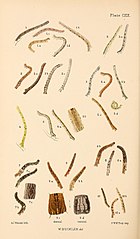Scopula emutaria, the rosy wave, is a species of moth in the family Geometridae. It is found in western and south-western Europe and Romania. Also in North Africa.[3]
| Rosy wave | |
|---|---|

| |
| Scientific classification | |
| Domain: | Eukaryota |
| Kingdom: | Animalia |
| Phylum: | Arthropoda |
| Class: | Insecta |
| Order: | Lepidoptera |
| Family: | Geometridae |
| Genus: | Scopula |
| Species: | S. emutaria
|
| Binomial name | |
| Scopula emutaria | |
| Synonyms | |
| |
The wingspan is 23–26 millimetres (0.91–1.02 in) (sometimes 20–24 millimetres (0.79–0.94 in)). Easy to distinguish by its whitish ground-colour, slight or rather strong pink flush. Most striking is the straight broad line over the wing towards the wing tip.[4][5]
Adults are on wing from June to July.[6]

It is a coastal species. The larvae feed on sea beet and Armeria maritima.[7]
Subspecies edit
- Scopula emutaria emutaria
- Scopula emutaria subroseata (Haworth, 1809)
References edit
- ^ "Scopula (Calothysanis) emutaria (Hübner, 1809)". Fauna Europaea. 2.6.2. 29 August 2013. Archived from the original on October 9, 2014. Retrieved 16 April 2017.
- ^ Sihvonen, Pasi (April 1, 2005). "Phylogeny and classification of the Scopulini moths (Lepidoptera: Geometridae, Sterrhinae)". Zoological Journal of the Linnean Society. 143 (4): 473–530. doi:10.1111/j.1096-3642.2005.00153.x.
- ^ Prout, L.B. 1912–16. Geometridae. In A. Seitz (ed.) The Macrolepidoptera of the World. The Palaearctic Geometridae, 4. 479 pp. Alfred Kernen, Stuttgart.
- ^ Peder Skou (1986). Leif Lyneborg (ed.). The Geometroid Moths of North Europe (Lepidoptera: Drepanidae and Geometridae) (in Danish). Vol. 6. Translated by Elizabeth Folino. E.J. Brill/Scandinavian Science Press. p. 48. ISBN 978-9004078598.
- ^ Meyrick, E., 1895 A Handbook of British Lepidoptera MacMillan, London pdf This article incorporates text from this source, which is in the public domain. Keys and description
- ^ UKmoths
- ^ Moths and Butterflies of Europe and North Africa
External links edit
Wikimedia Commons has media related to Scopula emutaria.